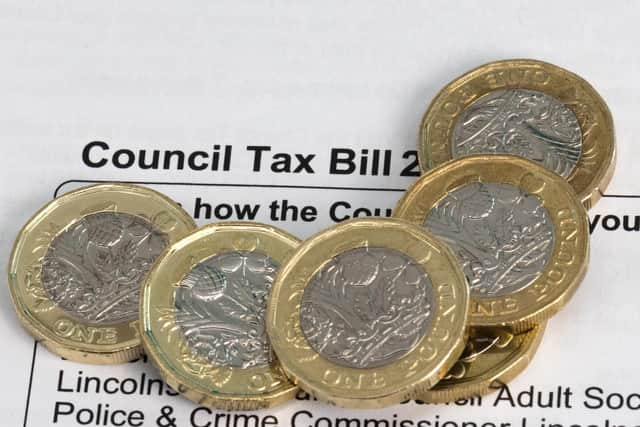Proposed council tax hikes are unjust and need to be rejected - Brian Monteith
The council Tax – supposedly levied by our councils to help fund the public services provided at a local level, such as education, roads, amenities, refuse collection and the like, – in truth reflects largely the level of funding made available by central government and various other restrictions on what local spending can be made without penalties of central funding being withdrawn.
As one of the more unpopular taxes of the early devolution period the SNP promised in its 2007 election manifesto to abolish it – but only froze then capped increases – which at least took the Council Tax off most voters’ agendas.
Advertisement
Hide AdAdvertisement
Hide AdThe restrictions on increasing the Council Tax forced local councils into operating with ever-shrinking resources, resulting in the slow but steady erosion of public services through the closure of libraries, swimming pools and other amenities.


In seeking to answer the failure to abolish Council Tax the SNP, with support from Labour, announced it would make the Council Tax “fairer” by increasing the relative Council Tax liability for properties in the higher valuation bands E , F, G and H. This is because Council Tax is set at the rate liable for a property in the valuation Band D (100 per cent) – with Band A at 67 per cent of Band D; Band B at 78 per cent; Band C 89 per cent. The more valuable properties of Band E were increased in 2017 from 122 per cent to 131 per cent of Band D; Band F from 144 per cent to 163 per cent; Band G from 167 per cent to 196 per cent and Band H from 200 per cent to 245 per cent.
The argument was that the increase reflected an ability to pay more – but the relationship between a person’s income and the value of a property occupied is weak. For the politicians, however, be they local councillors or Holyrood MSPs, it presented a relatively obscure and painless process with the majority of people occupying Bands A-D oblivious to the increase. For those inhabiting properties from Bands E-H the increase was more noticeable – but inflation in 2017 was still relatively low, with cpi only 2.7 per cent.
Now the SNP-Green government has agreed a deal with Scottish local authorities to change the multipliers again and has put it out to consultation, closing on September 20 this year. The proposal is that Bands A-D will again be left untouched and Bands E-H will go up by the same amounts as in 2017; taking Band E from its original 122 per cent to 139 per cent; Band F from 144 per cent to 175 per cent; Band G from 167 per cent to 213 per cent and Band H from 200 per cent to 268 per cent. It is intended that these changes be phased in from 2024/25 until 2026/27 – an admission surely that there will be real pain for taxpayers.
The reason this change should not go ahead is very simple – the values of properties do not reflect accurately the ability to pay, because properties reflect not just current incomes of some residents but also in many cases the past incomes of residents who once had disposable income that allowed them to purchase the property they are now in.


Having now retired on a typically lower income – often of a fixed nature with little ability to increase it when living costs go up – these residents are punished for being supposedly wealthy when they are in fact cash-poor. The injustice of using property taxes to deliver a progressive taxation system is there for everyone to see. Instead of our politicians being honest with us and putting up income taxes even more they seek to make property taxes progressive – but this is a blunt instrument – akin to deciding to taxing VAT at different rates depending on an individual’s postcode.
Apart from the madness of trying to administer such a method fairly it simply could not reflect what incomes people in a certain street might be earning.
This is the problem of treating a property tax as if it reflects ability to pay. We cannot simply presume people that live in the same two neighbouring properties have the same disposable income to pay a tax.
Advertisement
Hide AdAdvertisement
Hide AdThe system is skewered even more by the fact that the valuation bands are based on a properties equivalent value in 1991 (when Council Tax was proposed). For old properties there is some possibility of estimating the value based on records of the time but for all new properties since then the assessors need to make their own calculations.
This can and does throw up widespread anomalies where large properties can be placed in a lower valuation band than some smaller properties.
The answer to this is to conduct a comprehensive revaluation of all domestic properties – but this come at a high political cost as at least half of residents could expect to be presented with a new banding.
Experience shows those suffering make a lot of noise while those who gain are happy enough to stay quiet. It was such a rates revaluation in 1985 that resulted in the Community Charge being introduced in Scotland a year earlier than England (against Margaret Thatcher’s own advice).
If we are to have a property tax at all it has to have accurate valuations for it to have any chance of being equitable. The SNP-Green Government is ducking the hard question by looking to phase in a large tax increase to an estimated 28 per cent of properties.
The opposition parties should have none of it. This Council Tax Reform is only likely to hurt those on fixed incomes and encourage more aspirational people to see Scotland as a place to leave.
- Brian Monteith is a former member of the Scottish and European Parliaments and a senior advisor to the Tax Reform Council.
Comments
Want to join the conversation? Please or to comment on this article.